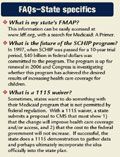How it's done: Financing and reimbursement of publicly funded pediatric health care
Second of three parts: Review of the infrastructure of financing and reimbursement.
Candice P. Chen, MD, assisted in the preparation of the manuscript of this article.
DR. FINE is a hospitalist, pediatric gastronenterology, and clinical instructor at Children's National Medical Center, Washington, D.C. He has nothing to disclose in regard to affiliations with, or financial interests in, any organization that may have an interest in any part of this article.
In the first part of this three-part series, Medicaid and SCHIP eligibility and benefits were detailed.1 This article reviews these programs' infrastructure of financing and reimbursement.
Governor Laurie Pane is facing a crisis. Her state budget is running a deficit for the third straight year, and the largest single expense is the Medicaid program. With re-election pending, she calls a meeting of her state Medicaid officials to discuss mechanisms and potential changes that might offer the state some relief.
In 2005, the cost of the Medicaid program is anticipated to exceed $320 billion,2 which is more than Medicare spent on medical care for the elderly. Considering that Medicaid, enacted in 1965, was essentially an afterthought to the Medicare legislation and passed through Congress with little debate,3 this evolution of expenses represents a significant shift in the health-care financing landscape.
Unlike Medicare, which is entirely federally-funded, Medicaid is a jointly-funded program. Costs for Medicaid participants are initially paid by states, which then submit statements to the Center for Medicaid and Medicare Services (CMS) for reimbursement of a percentage of expenses. How much each state is reimbursed depends on a state's per capita income: Poorer states are reimbursed more and wealthier states receive less. The federal matching assistance percentage (FMAP) is reviewed annually, and is subject to impassioned debate by governors and CMS officials.
For example: If a state lays out $300 million dollars for services to the Medicaid population, this will be reported to CMS. If the state has an FMAP of 50% (or 0.50), it receives $150 million in matched funds. If the state has an FMAP of 75%, it receives $225 million in matched funds. FMAP, by law, can be no lower than 50%, so states are guaranteed at least a dollar-for-dollar reimbursement. Currently, FMAPs range from 50% to 80% across the states.4
Medicaid financing is open-ended. There is no predetermined limit to the costs that can be incurred by the states of the federal government, except by way of defining eligibility and benefits in the state plan. Number of enrollees and service utilization determine how much money the governments will spend. This makes budgeting difficult and eliminates costs for states and the federal government. Therefore, in unexpected times of economic stress the increase in unemployed and uninsured seeking Medicaid can punish a state's economy even further.5
SCHIP is similarly jointly funded, although at a higher matching rate than Medicaid, so that states are encouraged to participate. A major distinction between SCHIP and Medicaid, however, is that SCHIP operates as a limited sum to states, called a block-grant. In this case, states are budgeted a certain amount of money to spend on the health insurance of children. Monies unspent by one state are redistributed to other needy states. Comparing the programs, while Medicaid cost an open-ended $320 billion in 2004, the entirety of the SCHIP program amounted to about $7 billion.1

Medicaid and SCHIP expenses have gone up about 8% annually over the past 10 years.4 Although this rate increase is less than what is seen in the private sector, it still strains government budgets. Combine these increasing health-care costs with the recent economic stagnancy, and it is clear why both the states and the federal government have looked at ways to limit Medicaid expenditures. They have considered several options to shift costs, generate additional income, or decrease expenditures.6
One way states can decrease costs is by shifting expenses to the federal government. An issue receiving ongoing legislative review is the amount that states submit to CMS for reimbursement. Medicaid statutes allow for some techniques that "draw down" federal dollars, in essence allowing the states to receive federal money for transactions that may only tangentially be related to patient care. The federal government has recently looked to decrease a state's ability to do this, and the state governments have predictably responded with strong opposition.